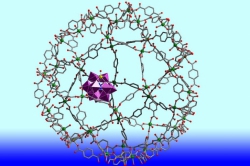During the development of a pathological process in a tissue, processes such as the increase of temperature and decrease of acidity take place, which can be used as a basis when designing drug delivery systems. Metal-organic frameworks are among the most promising drug delivery platforms. MOFs are porous polymers with a regular crystalline structure composed of a metal coordination center and organic ligands. Computer modeling can be used to predict properties of frameworks with different composition in order to choose the one most fitting for a particular drug.
Scientists from ITMO University modeled a manganese-based metal center of the framework and found out that it degrades under the effect of oxygen and hydrogen peroxide. This can be used in the design of delivery systems for anti-inflammatory and anti-neoplastic agents.

"During an inflammation process, active forms of oxygen emerge in cells. We've modeled how the simplest of them - oxygen and hydrogen peroxide - interact with the framework's metal center," comments Elena Khramenkova, member of ITMO's SCAMT Laboratory.
It turned out that though the framework is stable in water, it starts to degenerate when we add oxygen and hydrogen peroxide. This happens due to ions of manganese binding with oxygen and causing slight deformations of the porous structure. An accumulation of such deformations destroys the material. This makes the material ineffective in oxidation catalysis. Yet, if we load a drug into the framework and deliver it to a cell, it will release the drug only in places where oxygen, i.e. inflammation, is present.
According to the scientists, using quantum chemistry methods to describe the metallic center and local molecular interactions is only the initial stage of their research. In the future, they plan to model the framework in full, as well as the loading of the agents into pores. Such models will help to better understand this process and choose the optimal structure for the framework.

"We found out which molecular processes emerge at the interaction of a framework's entity with oxygen or hydrogen peroxide. In the future, we plan to model the framework material in full on the nanoscale. This is quite a large scale for theoretical chemistry and an ambitious goal. Still, we believe that such research will help to purposefully develop truly effective and safe drugs," notes Mikhail Polynski, another member of SCAMT Laboratory.
Reference: Degradation paths of manganese‐based MOF materials in a model oxidative environment: a computational study. Elena V. Khramenkova, Mikhail V. Polynski, *Alexander V. Vinogradov, Evgeny A. Pidko. The Royal Society of Chemistry.





